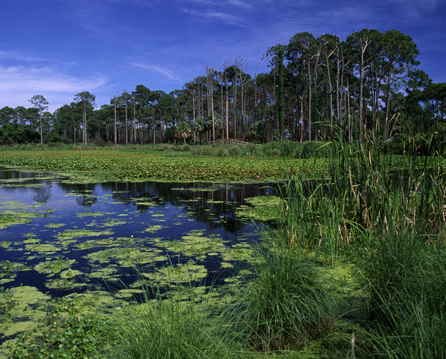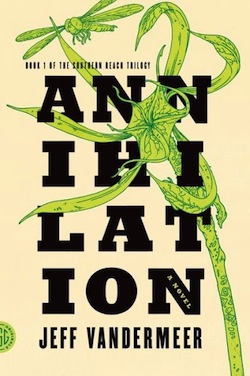Annihilation tells the story of a scientific expedition into Area X, a remote part of the continent in which strange things have been happening. The expedition is the twelfth; previous expeditions have ended in suicide, murder, and rapid death from sickness for the survivors. It is the first in a trilogy. Annihilation will be released on February 4th from Farrar, Straus & Giroux. The second book, Authority, comes out on May 6th, and the last book, Acceptance, arrives on September 2nd. I had a chance to talk with VanderMeer by email as he was gearing up for his book tour.
Brian Slattery: Annihilation is getting compared to the work of all kinds of other people, from H.P. Lovecraft to J.J. Abrams to Stanley Kubrick. The closest one for me, though, was Roadside Picnic by Arkady and Boris Strugatsky. In both your book and theirs, people are being sent in to investigate a geographic area that has been… changed… by forces that are, pretty much from the get-go, beyond our comprehension. In Picnic, though, the forces are overtly alien. In Annihilation, they appear to be natural. Putting those two together offers a neat comparison—Annihilation seems to suggest that the natural world is like your archetypal alien civilization in a first-contact book: way more advanced than we are and therefore essentially incomprehensible, at least until we catch up—if we ever do.
Jeff VanderMeer: It’s hard to answer in the sense of not wanting to give away spoilers for the next two books by confirming or denying anything. But I do think we often look at nature as being alien or we romanticize it, or we see ourselves, to be charitable, as stewards, or, less charitably, as having the right to take and despoil whatever we like. And yet as you say the natural world is incredibly complex, to the point that it often makes our smart phones and other advanced technology look incredibly basic and clumsy. We also seem to think that we know so much about our world, and yet we’re only now discovering that, for example, plants engage in quantum mechanics during photosynthesis and that sunfish and albatrosses have a complex symbiotic relationship. In essence, we live on an alien planet without realizing it—and I mean that in a good way; something to celebrate and relax into, even though mostly the reactions I see are “shark bad, lemur good.” But there is also something else going on in Area X other than a heightened awareness of a basic sophistication we often want to deny. Although some wildlife is eerily changed in Annihilation, there’s also a lot of animals just walking around, going about their business.

BS: You’ve mentioned in a couple places—including the acknowledgements of the book—that Area X draws heavily from the St. Mark’s National Wildlife Refuge in Florida. How much of Area X is pulled directly from the wildlife refuge? How much is you enhancing or changing what’s really there? And is there anything about the refuge in reality that turned out to be too weird to be believable as fiction?
JV: Well, I have met people who believe there are aliens out there. But in terms of the landscape there, the book’s very faithful to the topography and the ecosystems you can find there—it’s a truly unique and valuable place in how it transitions from pine forest to cypress swamp to marshes with brackish water, and then to the seaside. It’s a wealthy and burgeoning ecosystem. I’ve been charged by a wild boar out there (as happens to the expedition in the novel), seen dolphins in freshwater canals at high tide, had to jump over an alligator blocking a path with water on both sides, seen a Florida panther out there (a long time ago), and much more. So I didn’t really make anything up in terms of the natural elements in the novel, except some fudging of the distance between places and adding a couple of additional landmarks. And, of course, finding that a distance where I don’t name places worked very well for how the story is told.
BS: Area X also seems to partake of other places humans have famously closed off—like, say, the Zone of Alienation that surrounds the Chernobyl reactor in Pripyat, Ukraine, or nuclear test sites near military bases in the United States.
JV: That’s the urban myth side of things, whereby Area X is kind of hazily known by the outside world. And, of course, the basic dilemma is of having a secret agency sending in expeditions to explore and discover what is going on in Area X, while part of what’s happening in Area X is that it’s all being purified. In book two, a scientist jokes, “What, should we go in and contaminate it with heavy metals?” And it points at one essential thing, among a few essential things, I wanted to explore: How do we get beyond the human gaze, the human need for our environment to serve us? What if in order to survive we need to imagine the world without us, or to, at the level of heart and bone, acknowledge, and act on, the idea that possibly we, as much as any Area X, are making things tough for this planet?
BS: Despite the fact that I just compared Annihilation to Roadside Picnic, the thing that the book really reminded me of most of all is your previous books—particularly in the way that the characters become infected or colonized by the area that they’re in the longer they stay there, and the way that each of them seem to have individual reactions to their colonization. You find fresh angles to this theme with every book. What keeps you coming back to it?
JV: I’m not really sure. I don’t see the book as very much like the prior ones—whereas in the Ambergris books we’re talking about that being the central theme in a sense, here it’s more part of something larger, of which it’s just a small part. I think this becomes clearer in book two. Each book kind of pivots and shows you something different, or some other side of things.
BS: In Annihilation, too, the themes that I’ve come to think of as VanderMeerian appear here in a particularly distilled form. Was this intentional, or did it just turn out that way?
JV: It’s hard for me to see it that way, because of this series being more rural and set in wilderness areas. I also joke around that Authority, the second book, is set almost entirely in hallways and parking lots, behind buildings, and in abandoned lots and stairwells (and thus far, still a page-turner, according to readers!). Which may seem like it doesn’t make a difference, but it really does to me, compared to the ultra-urban settings of the prior novels. That, and the way in which there’s an emphasis on certain aspects of the characters makes it a different entry point for the reader, too.
BS: Then there are these other elements to the book—that the area is closed off and examined by a government agency that appears to have sinister motivations, that the area itself seems to be pushing back against this (I don’t want to give too much away)—that I assume are going to be taken up in the next two books. Care to give us a sense of what we can expect?
JV: Whereas Annihilation is an expedition into Area X, Authority is an expedition, in a sense, into the Southern Reach, following the new director, who has just taken over and has to make sense of both what he finds in the agency and the repercussions of what happens to the twelfth expedition. In doing so, he has to kind of untangle a lot of conflicting impulses within the agency. And then Acceptance is split between Area X and the Southern Reach as things kind of come to a head, although across threads spanning the full thirty years that Area X has been in existence.
Brian Slattery is an editor, writer, and musician. His first three books were published by Tor.










